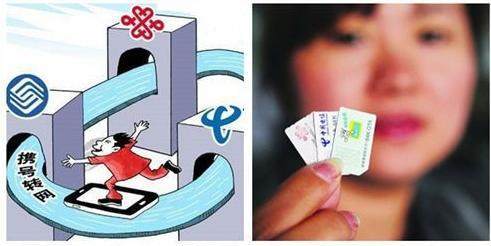Can the three major operators carry the number to the network?
The port number transfer means that the mobile phone user can keep the original phone number unchanged when changing the contracted carrier within the local network. For example, if the user is currently a mobile user and wants to keep the number using the service of China Unicom, you can use the port number transfer service. But for operators, after all, it involves the direct interests of the three major operators.

If you don't involve interest, you are their God. It involves the issue of interest, and everyone must be anxious. Therefore, if you want to transfer to the network, you have to face the limitations of the three major operators. A lot of process audits, cumbersome for you to scratch the wall. You don't know when you sign the contract, you will not be able to transfer the net, so many warriors will simply return to the ordinary people just by asking.
Opening a port number transfer may increase the number of users of another carrier, but it will also erode users of other companies (such as mobile). After all, the current mobile phone number is still the main contact method of the Chinese people. Many people's numbers have been used for a long time and it is very troublesome to change. It is not a portable barrier to prevent users from losing. In the United States, the mobile phone number can be easily converted to the company. It is very simple. Just give the mobile phone number of the company you want to transfer and the service password of the original company. Free, about 10 minutes in total.

At present, there are only a few hundred applications for transfer to the network in China. Involving the interests of operators, most of the network users are in compliance with the conditions of network transfer, and are maliciously obstructed by operators. Although the port number transfer network has been used as an anti-monopoly measure in many countries and regions, for China at this time, the port number transfer network that has been delayed for too long has not been implemented.
In the Internet era, WeChat Taobao's various bindings make people's dependence on mobile phone numbers stronger than before, and it is even more difficult for weak operators to develop a new user. Under this circumstance, the port number transfer should be launched as an early policy to maintain competition and promote competition in the industry. It is unnecessary to delay it. Only from the perspective of Asia, including Japan, South Korea, Singapore, India, Hong Kong, Macao and other countries and regions have been implemented.
The report of the Telecommunications Research Institute of the Ministry of Industry and Information Technology pointed out that the success rate of users' number-to-network transfer application is not high. The reason is that operators avoid artificial user churn and artificially set various thresholds through technical means to prevent users from carrying out.
For the port number transfer policy, operators have different attitudes. For China Mobile, which has the advantage of users, considering the negative impact of the port number transfer on the network, it is not the advocate of the port number transfer policy or even the boycott. For China Telecom and China Unicom, considering the effect of two-way port number transfer may bring uncertainty to them, they will have more expectations for the one-way port number transfer policy.

The original intention of porting the number to the network is to meet the needs of users and promote the healthy development of the telecommunications industry. Once the bottleneck of the port number transfer is broken, the user's choice is more free and the existing monopoly of the telecommunications will be changed. This will force the operators to provide more reasonable package matching and more detailed services. "Sincerity" to reform.
What is Battery Holder?
Battery Holders are devices used to hold and secure batteries in electronic devices. They come in various shapes and sizes, depending on the type and size of the battery they are designed to hold. Battery holders are typically made from plastic or metal materials and feature spring-loaded contacts that connect to the battery terminals to provide power to the device. They are commonly used in electronic devices such as toys, remote controls, flashlights, and other portable devices that require batteries for power. Battery holders are essential components in electronic devices, as they ensure that the batteries are held securely in place and provide a reliable source of power for the device.
Choosing the right Battery Holder.
The kind of battery holder required depends on the below factors:
Size of the batteries being used (AAA, AA, C, D, etc.)
Number of cells being used
Compatibility of the cells being used with the battery holder
Contact and terminal style
Most battery holders are specifically manufactured for a particular type of batteries. However, many battery holders will be compatible with similar batteries with different chemistries. One point to note here is that if a battery holder houses batteries of different chemistries at the same time, the power being delivered will be in line with the weakest battery. Hence, using batteries with the same chemistry is advisable for optimum performance.
Types of Battery Holder Mounts.
The way the battery holder is attached to the cell-powered device is known as the battery holder mount. The different types of battery mounts are:
Panel Mount:
A panel mount battery holder is a separate compartment designed to hold cells. It can be inserted into a cavity in the device that needs power. It can be removed when the batteries need to be changed. They are inserted in the device cavity by screwing in or have Flange Panels.
Slide-In Mount:
In this type of mount, the cells are inserted and removed by sliding in or out. They are the most commonly used mounts and also economical. When a cell is slid in place, it is held by a cover or by the opposing force of two terminals. This type of mount is quite reliable, too.
Chassis Mount:
This type of mount is fixed inside the main body of the device to a surface plate. These mounts come in plastic as well as metal.
PCB Mount:
As the name suggests, the PCB Mount is for when the battery needs to be on a PCB. It has sharp pins around the perimeter which can be used to fix it on a PCB. Usually, they are used to hold coin cells. However, PCB mounts are also made for AAA or AA cells.
Strap & Lead:
They are not entire housing units, but make it possible to attach a battery to an electronic device or holder. It just has a wire and two press studs to hold a cell. Replacement of the cell becomes easy in this method.
Snap-In Mount:
It consists of tensioned metal clips to hold a cell securely in place. The battery is to be pushed into the housing until it snaps in place. This type of mount is best suited for systems prone to shocks and vibrations.
Wire Lead Mount:
This type of mount provides a good level of flexibility in terms of the places where it can be used. It has two wire leads at one end while the other end can be fixed to the device being powered.
Surface Mount:
This type of mount is usually used for coin cells. It lies flat inside the device or within a circuit. It is open-faced and has button terminal contacts.
Through-Hole Surface Mount:
This is best suited to hold batteries where space is a constraint. Instead of being inserted into a cavity in a device, it is fixed on the surface of the device through holes.
Battery holders are often not taken seriously enough when designing systems. However, a reliable battery holder is an important component that contributes to the reliability of the entire system.
Battery Hoders, Battery Case, Battery Socket, Battery Clips, Coin Cell Battery Holder
HuiZhou Antenk Electronics Co., LTD , https://www.atkconn.com